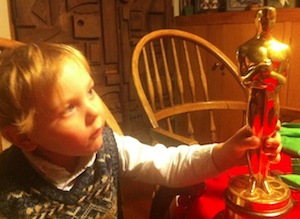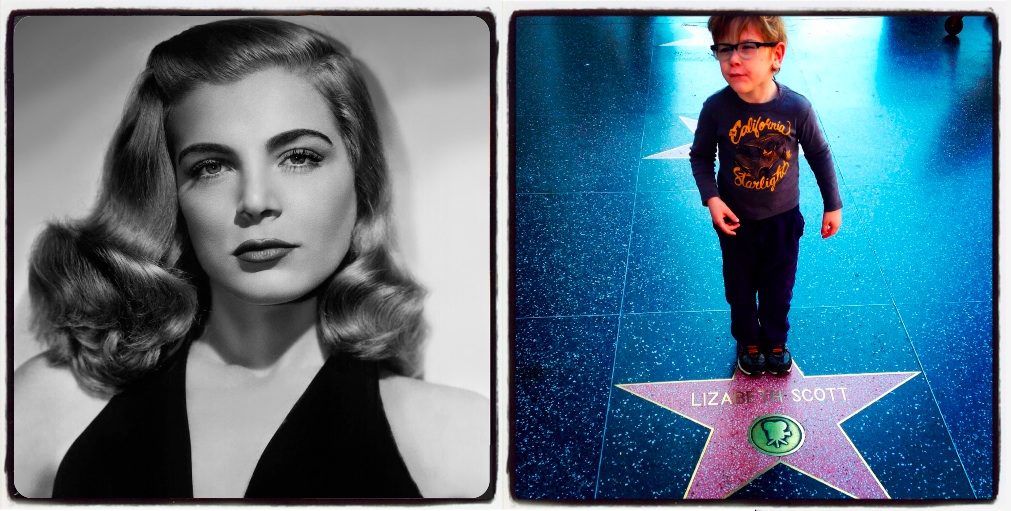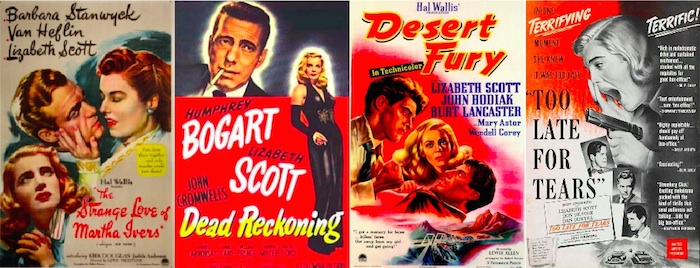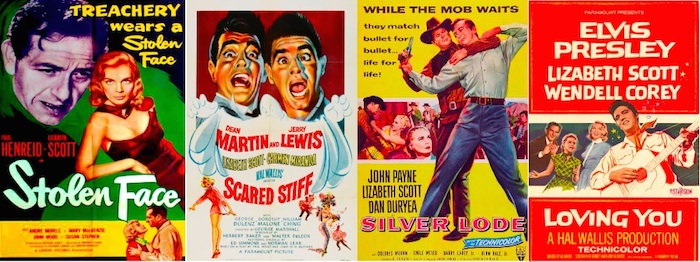 A weekly feature in which my five-year-old son is let loose on the Hollywood Walk of Fame, one of the most popular tourist attractions in Los Angeles, and chooses a star from among the more than 2,500 honorees. His “random” picks sometimes reveal unexplained connections such as the summer day in 2012 when he sat down on the star of actress Celeste Holm and refused to budge. We later learned that the Oscar-winning actress had died only hours earlier. There are five categories on the Walk of Fame: motion pictures, television, radio, music and theater but Charlie tends to favor the movies.
A weekly feature in which my five-year-old son is let loose on the Hollywood Walk of Fame, one of the most popular tourist attractions in Los Angeles, and chooses a star from among the more than 2,500 honorees. His “random” picks sometimes reveal unexplained connections such as the summer day in 2012 when he sat down on the star of actress Celeste Holm and refused to budge. We later learned that the Oscar-winning actress had died only hours earlier. There are five categories on the Walk of Fame: motion pictures, television, radio, music and theater but Charlie tends to favor the movies.
Charlie and I have been off the Boulevard for a while and I was a little reluctant to share his latest Walk of Fame pick because it seemed so implausible that he’d choose someone (again) who had just died. But, as God is my witness, I had nothing whatsoever to do with Charlie’s pick of sultry Lizabeth Scott, who for about a decade, was such a unique and wonderful presence in the world of film noir. And who am I to suppress Charlie’s legitimate choice for the week?
To be honest, when I was first introduced to the films of Lizabeth Scott years ago, I thought of her as a “B-list Lauren Bacall.” As I saw more of her films, I regretted giving her that label (which, unfortunately, was a bias Scott had to deal with throughout her career). My favorite of her films is The Strange Love of Martha Ivers from 1946, featuring Barbara Stanwyck, Van Heflin, Kirk Douglas, and Lizabeth Scott as ex-convict Toni Marachek. I also admire Lizabeth’s performances in films such as Dead Reckoning (1947), Desert Fury (1948), and Too Late for Tears (1949). Because of Scott’s recent death at the age of 92, I won’t go into my usual shpiel. You can read excellent summaries of her career in her obituaries — here’s one from The New York Times and another from Variety.
Instead, I always find it fun to dip into the newspaper archives and see how the stars were viewed when they first caught the public’s eye. Before she came to Hollywood, the former Emma Matzo of Scranton, Pennsylvania, made a name for herself on the stage (even if that name was constantly changing — from Emma to Elizabeth to the unique Lizabeth). After appearing in summer stock as a teen and moving to New York to train in the theater, 18-year-old Scott got cast in the traveling company of Hellzapoppin, a musical revue written by former vaudevillians Olsen and Johnson that was a huge success. She stayed with that play for over a year and then returned to New York where she joined an off-Broadway theater company, appearing in several plays, including a starring role as Sadie Thompson in Rain. That led to her biggest break yet — getting cast as Tallulah Bankhead’s understudy (Tallulah was not pleased) in Thornton Wilder’s new play, The Skin of Our Teeth. Scott recalled her prickly relationship with Bankhead in a 1945 interview.
“I was sitting backstage and Tallulah looked at me and said, ‘Close that door.’ Being the meek little understudy, I closed it.”
Couple of nights later, Tallulah again said, “Close that door.” Lizabeth said, “Say please, Miss Bankhead.”
Tallulah didn’t say please. Lizabeth didn’t close the door. Tallulah glared. Lizabeth glared back. They didn’t speak for weeks.
“Finally,” Lizabeth said, my uncle came to see the show and wrote me a note in which he glowingly praised Tallulah’s performance. I showed it to her. That did it. We’ve been friends ever since.”
Lizabeth ultimately quit her understudying gig but was called back when actress Gladys George suddenly left the production. The producer begged Lizabeth, on the eve of her 21st birthday, to return to the show in George’s part as Sabina the maid. She proved to be a big hit. Theatre critic Lawrence Dame witnessed Scott’s performance.
I saw Lizabeth Scott play Sabina Wednesday night. She did a magnificent job. Supple in a role that calls for much body-swishing, full of earthly vitality and exciting, intriguing gestures, with a voice that you had to get used to at first, but one that amply revealed the emotional, poetic, highly intelligent spirit of the girl, her Sabina did more than any other part to illuminate the play and stress what Thornton Wilder had in mind when he wrote it. No lines were missed, no subtlety overlooked.
I wonder what Miss Bankhead thought about that review. Some people have suggested that Mary Orr’s short story, “The Wisdom of Eve,” which became the basis for the film All About Eve, about a conniving young actress who befriends her aging idol only to ultimately victimize her, was based on the Bankhead-Scott rivalry, but that seems quite unlikely and not at all accurate.
 Hollywood soon came calling, specifically producer Hal Wallis who had just left Warner Bros. for Paramount and was determined to find a star to match Warners’ new discovery, 20-year-old Lauren Bacall who was a sensation in her first film, To Have and Have Not. Let’s face it, it was hard not to compare Lizabeth and Lauren — they had similar looks and similar unusually low voices. Both had been models in New York and both had appeared on the cover of Harper’s Bazaar.
Hollywood soon came calling, specifically producer Hal Wallis who had just left Warner Bros. for Paramount and was determined to find a star to match Warners’ new discovery, 20-year-old Lauren Bacall who was a sensation in her first film, To Have and Have Not. Let’s face it, it was hard not to compare Lizabeth and Lauren — they had similar looks and similar unusually low voices. Both had been models in New York and both had appeared on the cover of Harper’s Bazaar.
“Prepare for the huge buildup of Lizabeth Scott,” columnist Sheila Graham bellowed in May 1945.
The story behind this story is the feud between Hal Wallis and Jack Warner. When Hal left the Warner studio, he was determined to find, and build up, a star to match the studio discovery, Lauren Bacall. He picked Miss Scott, who was once understudy to Tallulah Bankhead. Like Lauren, Lizabeth will sing in her first movie. Like Lauren, she has a low husky voice — only with her it’s natural; Lauren had to acquire hers. Wallis is now in New York with 2,000 sultry photographs of the sexy Miss Scott, and these will be planted in newspapers and magazines in one of the biggest publicity campaigns ever given a new star.
Scott’s first film was a starring role as Ivy Hotchkiss (a part intended for Barbara Stanwyck) in John Farrow’s You Came Along opposite Robert Cummings from a screenplay by, of all people, novelist Ayn Rand. Oy. I have to admit I’ve never seen this odd-sounding film but from there, Lizabeth went right into my favorite, The Strange Love of Martha Ivers, even though Stanwyck objected to Scott’s casting at first. And then she made Dead Reckoning with Humphrey Bogart in a part which was turned down first by Rita Hayworth and then, yes, by Bogart’s wife, Lauren Bacall.
I feel bad that the talented actress had to deal with constant comparisons to Bacall. While she starred in many well regarded film noirs, she never really enjoyed Lauren’s level of success (ugh, I’m doing it again!). Other films of note include the British Stolen Face (a 1952 precursor to Hitchcock’s Vertigo), the Dean Martin/Jerry Lewis film Scared Stiff in 1953, and the political Silver Lode in 1954 which many saw as an anti-McCarthy film. Scott also appeared on live television during the 1950s but her stage fright began getting the best of her. Her name became mired in scandal when Confidential magazine alluded to the fact that the unmarried Lizabeth Scott was active in Hollywood’s underground lesbian community. Scott sued the magazine for libel but the case was dismissed. Some say that scandal had a big part in Scott’s retreat from the limelight. Her final film role was opposite Elvis Presley in Loving You in which she played a ruthless publicist who wants to make a star out of country bumpkin Elvis. Scott is definitely the “older woman” in the film, at the ripe old age of 35. She did make one more brief appearance in front of the camera, in 1972’s Pulp starring Michael Caine.
I’m glad Charlie chose to honor this beautiful and talented actress who definitely had her own style.



